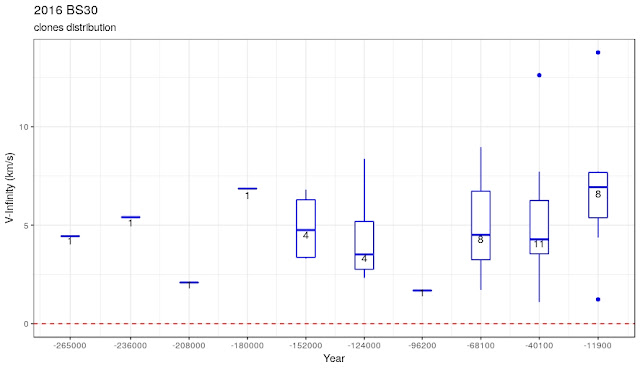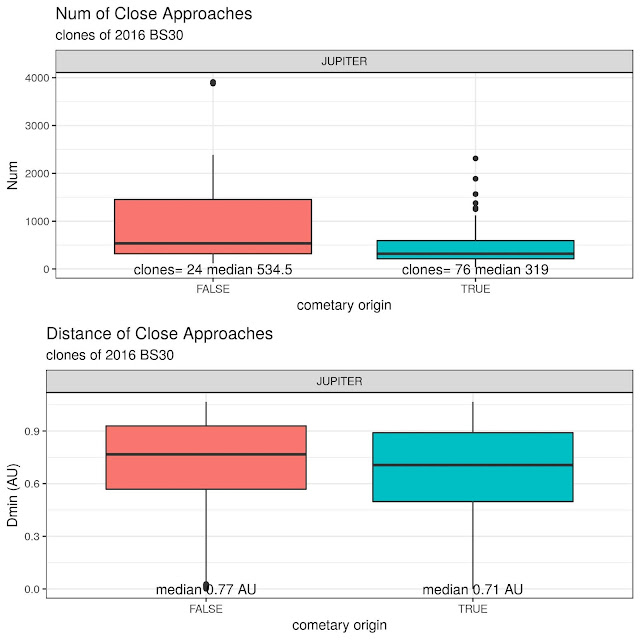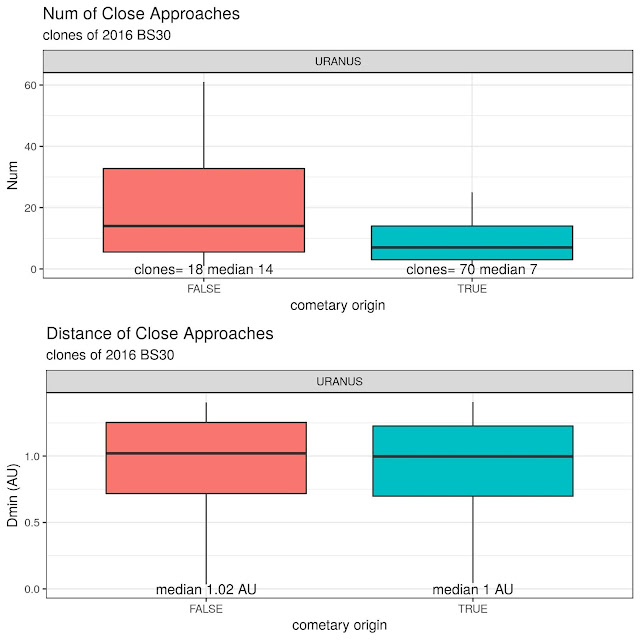(2016 BS30)
| Classification: Outer Main-belt Asteroid SPK-ID: 3743356 |
| [ Ephemeris | Orbit Diagram | Orbital Elements | Mission Design | Physical Parameters | Close-Approach Data ] |
[ show orbit diagram ]
| Orbital Elements at Epoch 2458200.5 (2018-Mar-23.0) TDB Reference: JPL 9 (heliocentric ecliptic J2000)
| Orbit Determination Parameters
Additional Information
|
Clones generation
I generated 100 clones trying to achieve the same orbital parameter distribution as shown above (mean and sigma).
This is a table comparing what has been achieved versus the target:
| clones_mean | clones_sd | target_mean | target_sd | ||
| q | 2.4914019 | 0.0000034 | 2.4914021 | 0.0000034 | |
| e | 0.3478864 | 0.0000008 | 0.3478864 | 0.0000008 | |
| i | 11.6772762 | 0.0000767 | 11.6772853 | 0.0000764 | |
| peri | 245.4466251 | 0.0002691 | 245.4466373 | 0.0002697 | |
| node | 326.2245392 | 0.0000916 | 326.2245320 | 0.0000913 | |
| tp | 2457744.5376278 | 0.0018291 | 2457744.5376832 | 0.0018283 | |
Backward simulation
I used the Bulirsch-Stoer algorithm implemented by the Mercury software by J.E.Chambers (1999):
"A Hybrid Symplectic Integrator that Permits Close Encounters between Massive Bodies."
Monthly Notices of the Royal Astronomical Society, vol 304, pp793-799.
Integration parameters
----------------------
Algorithm: Bulirsch-Stoer (general)
Integration start epoch: 2458200.5000000 days
Integration stop epoch: -100000000.0000000
Output interval: 100.000
Output precision: medium
Initial timestep: .050 days
Accuracy parameter: 1.0000E-12
Central mass: 1.0000E+00 solar masses
J_2: 0.0000E+00
J_4: 0.0000E+00
J_6: 0.0000E+00
Ejection distance: 1.0000E+02 AU
Radius of central body: 5.0000E-03 AU
Includes collisions: no
Includes fragmentation: no
Includes relativity: no
The arbitrary threshold to consider an asteroid to be ejected from the solar system (or to enter it in case of backward simulation) is 100 au.
All planets from Mercury to Pluto plus asteroids Ceres, Pallas and Vesta have been taken into account.
Simulation results
76 out of 100 initial clones have entered the solar system from a distance greater than 100 au.
The graph below has to be read from right to left (the number of clones decreases as you go in the past - the simulation time has been divided into 10 intervals).
The arrival time into the solar system has the following density distribution:
In the following graphs, the simulation time has been divided into 10 intervals: in every interval and for every clone we find the maximum value for the relevant orbital parameter.
Orbit Specific Energy
Some clones were on a hyperbolic orbit with the following v-infinity:
Orbit eccentricity
Orbit Inclination
Analysis of Close Approaches
Kind Regards,
Alessandro Odasso














No comments:
Post a Comment
Note: Only a member of this blog may post a comment.